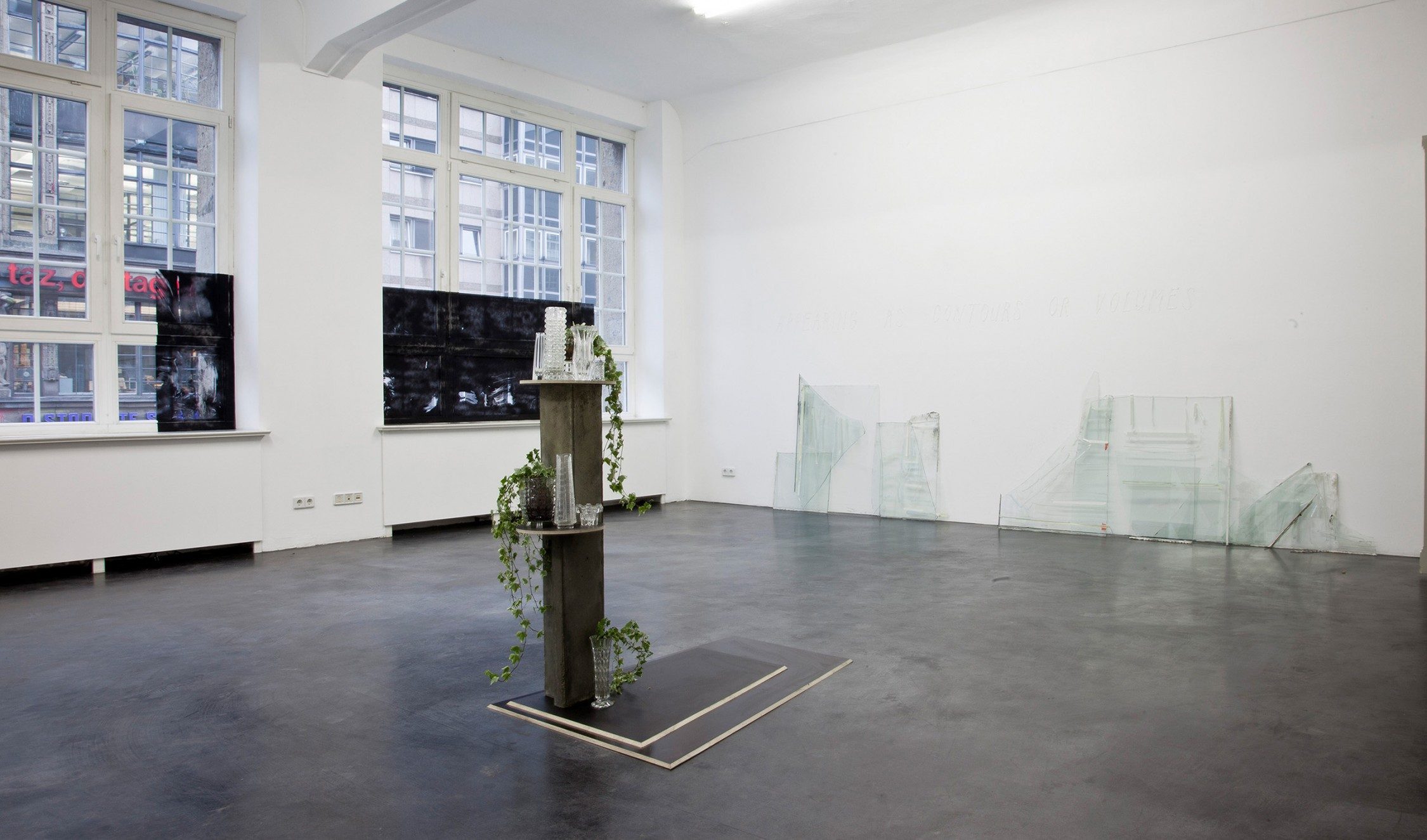




In December 2001, a new boutique was opened by the fashion label Prada on the Broadway in New York. In an area of 7000 sqm, unusually expensive clothing was showcased and sold in a museum-like setting. The central, downward-sloping, wavelike room was designed by Rem Koolhaas for Guggenheim SoHo. After Guggenheim closed the branch for economic reasons, Prada took over the entire design and the rooms with scarcely any modifications. In Spring 2005 a single shoe was presented on a pedestal in the basement of the boutique, together with the brief request to not touch it.1
Owning something means being able to touch it and no longer being ›merely‹ an observer. Max Schaffer tells an ambivalent anecdote about this. The current exhibition at the gallery Alexander Levy, which presents the work of younger artists living in Berlin, begins with this anecdote. For the work »Untitled (Berlin, 2012)« the individual sections of a window pane have been leant against the wall of the gallery and grouped by Max Schaffer in such a way that the raw, fragmentary forms develop aesthetic qualities and oscillate between a picture and a three-dimensional space like an ambiguous pattern (»APPEARING AS CONTOURS OR VOLUMES«). The broken window originates from an optician who provisionally stuck the sections together after someone had broken into his store. This means that strictly speaking, three people were involved in producing the work: the burglar, the optician and then, in the final phase, the artist. The burglary has transformed the state of “only being permitted to look” – stopped by an invisible boundary – into one of “being able to enter”2, while behind the window only the visual aides could be found: viewpoints and spatial limitations get mixed up.3 At the other end of the exhibition, visibility and the desire to see have been quasi inverted and hollowed out in one exhibit. »SETI«4, which has the appearance of a highly complex polyhedron, becomes a hole without sound or light as soon as it is entered. Felix Kiessling robs the viewers (who are not able to remain ›viewers‹) of the possibility of accessing the work in a distanced, impassive, evaluative way and creates an empty space that allows for a maximum amount of concentration, causing everyone who enters it to rely on themselves. In Ekaterina Burlyga’s work »1110« visibility and audibility, which are lacking altogether in »SETI«, are strongly linked: in a cube made of raw steel, a dark waste oil that has a disembodied appearance is set in motion by a series of deep, loud bass tones. The surface forms waves and flattens out again, creating fleeting shapes and then fraying upwards in a short, ecstatic moment. The minimalist cube is animated and churned up from within before the waste oil once again freezes to form a flawless surface.
The large-format photographs by Marius Glauer also revolve around their meaning5, aesthetic clarity and reversal, aspects that operate in the boundary between abstract, two-dimensional compositions and real objects, doubled by photography. The strange acrylic objects that can be seen on the photos are reminiscent of distorted vases or melted vessels, which enter into a peculiar relationship with one another as pure, coloured forms in an inverted, reversed space.
Ari Sariannidis presents surfaces of another kind: imitation marble, formica and concrete, which have been grouped together to create architectural forms and fragmentary collages somewhere between Hellenic antiquity and a modern overspill town. In »untitled«, excerpts from »Jason and the Argonauts«, a monumental, mythological film from the early sixties, are combined with pictures from a GDR home decorating magazine – against the background of a kitschy and coarsely-grained marble print. In »Rudow«, the childhood of the »GDR-Greek«6 Sariannidi seems like a utopia that has become a socially deprived area: the »Gropiusstadt«, whose paradox nature is evoked in the form of gently falling ivy tendrils amidst cheap materials. The works by Eva Vuillemin, in collaboration with her mother Ruth Erdt, must also be perceived in the light of her biography. Erdt, who is meanwhile a renowned photographer, has constantly used her own family as a motive. In »Spaghetti (Me&My Mother)«, Vuillemin transforms her relationship between exploitation, affection and ambivalent tenderness into a restrained, emotional fight with pasta – a fight which does after all very much transcend her own biography.
And the shoe? »As one of my favourite poets, Ezra Pound, once said, the beef stew cooking on the stove doesn’t need any advertising. It has advertising. It has its aroma. You can smell the beef stew on the stove. But the beef stew in the can has to be advertised. Somebody has to sell it to you. It can’t sell itself.« (Carl Andre, 1968)7
Text: Lukas Mathis Töpfer